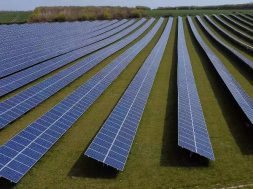
Tin perovskite thin film tandem solar cell patent granted by the US Patent Office to Solar-Tectic LLC
Solar-Tectic LLC (“ST”) announced today that a patent application for a tin perovskite/crystalline silicon thin film tandem solar cell has been allowed by the US Patent and Trademark Office (USPTO). The patent, the first for a perovskite layer on crystalline silicon thin-film (tandem), covers all non-toxic perovskites and inorganic materials. The inventor is Ashok Chaudhari, CEO of Solar-Tectic.
Recently perovskite materials have gained much attention as a promising solution to the long-standing problem of solar cell efficiency, which is of primary importance in today’s solar panel market. And while there have been reports of perovskite/silicon (wafer) tandem solar cells (and extensive intellectual property) remarkably there has been none on a perovskite/crystalline silicon thin-film tandem solar cell, until Solar-Tectic LLC’s recent breakthrough (http://www.nscj.co.uk/JECM/PDF/3-2-2-Chaudhari.pdf). Wafer sized bottom poly- and monocrystalline silicon layers in PERC, PERL, HIT, HJ, or perovskite/silicon tandem cells are typically 200-280 microns thick, whereas ST’s thin-film crystalline inorganic bottom layers can be as thin as 20-30 microns with the same or similar efficiency; moreover, they can be processed at much lower temperatures thereby lowering costs of production significantly. The top perovskite layer is less than only 1 micron – an ultra-thin film — and a thin film crystalline silicon (CSiTF) bottom layer decouples the need for a silicon wafer. If the price of polysilicon rises – due to tariffs or otherwise — less silicon material use will be an additional cost savings.
An example of the perovskite layer is CsSnBr3 which has a bandgap of 1.75eV, ideally suited as a top layer on silicon thin-film which has a bandgap of 1.12eV. Such a tandem solar cell is capable in theory of 45% efficiency, though ST has set a more realistic 30% efficiency goal, higher than the best silicon wafer technologies such as PERC, PERL, HIT, HJ cells with 25-26.6% efficiencies. The efficiencies of today’s solar cells on the market in general range from 14% – 25%. A cost effective 30% efficient solar cell with a simple design would revolutionize the solar energy industry by dramatically reducing the balance of system (BoS) costs, thereby eliminating the need for fossil fuel generated electricity entirely. Silicon wafer technology based on polycrystalline or monocrystalline silicon, which is 90% of today’s market, would become obsolete.
Importantly, the entire ST process is environmentally friendly since non-toxic Sn (tin) is used to deposit the crystalline silicon thin-film material for the bottom layer in the tandem configuration as well as in the top, perovskite, layer. The more commonly used toxic Pb (lead) is not used in the perovskite here. The processing methods used in this technology are conventional and similar to those used in today’s thin-film solar cell industry, and importantly also in the display industry.
The breakthrough patent is one in a “Tandem Series” of solar cell technologies which has been launched by ST, and that includes a variety of different proven semiconductor photovoltaic materials (i.e. III-V, CZTS, a-Si, etc) for the top layer on silicon (or germanium) bottom layer, on various substrates including flexible glass and polyimide for R2R (roll to roll) processing (see link for flexible glass paper http://www.sciencedirect.com/science/article/pii/S0167577X15300999).














